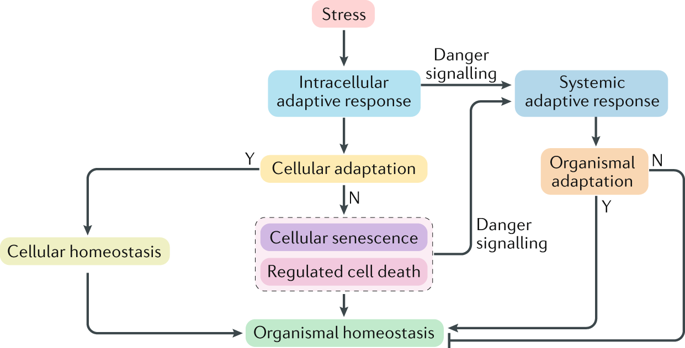Nature Reviews Molecular Cell Biology ( IF 81.3 ) Pub Date : 2018-10-10 , DOI: 10.1038/s41580-018-0068-0 Lorenzo Galluzzi , Takahiro Yamazaki , Guido Kroemer

|
Mammalian cells respond to stress by activating mechanisms that support cellular functions and hence maintain microenvironmental and organismal homeostasis. Intracellular responses to stress, their regulation and their pathophysiological implications have been extensively studied. However, little is known about the signals that emanate from stressed cells to enable a coordinated adaptive response across tissues, organs and the whole organism. Considerable evidence has now accumulated indicating that the intracellular mechanisms that are activated in response to different stresses — which include the DNA damage response, the unfolded protein response, mitochondrial stress signalling and autophagy — as well as the mechanisms ensuring the proliferative inactivation or elimination of terminally damaged cells — such as cell senescence and regulated cell death — are all coupled with the generation of signals that elicit microenvironmental and/or systemic responses. These signals, which involve changes in the surface of stressed cells and/or the secretion of soluble factors or microvesicles, generally support systemic homeostasis but can also contribute to maladaptation and disease.
中文翻译:

将细胞应激反应与系统体内稳态联系起来
哺乳动物细胞通过激活支持细胞功能并因此维持微环境和机体动态平衡的机制来对压力作出反应。细胞内对应激的反应,其调控及其病理生理意义已得到广泛研究。然而,对于受压细胞发出的,能够在组织,器官和整个生物体之间进行协调的适应性反应的信号知之甚少。现在已经积累了大量证据,表明响应不同压力而激活的细胞内机制-包括DNA损伤反应,未折叠的蛋白质反应,线粒体应激信号传导和自噬以及确保增殖性失活或消除末端受损细胞的机制(例如细胞衰老和受调控的细胞死亡),都与引发微环境和/或全身反应的信号的产生有关。这些信号涉及应激细胞表面的变化和/或可溶性因子或微泡的分泌,通常支持系统体内稳态,但也可能导致适应不良和疾病。

















































 京公网安备 11010802027423号
京公网安备 11010802027423号